emma & george hersey
Subject : Emma Hersey née Edser (b ca 1836 – d 1893)
George Hersey (b 1868 – d 1920)
Researchers : Julia Browne and Mike Brock
Vagrancy, workhouse, prison, family intrigue – the lives of Shere mother and son
Emma and George Hersey were mother and son living in the Shere area, suffering great personal hardships which saw them forced into the Guildford Union Workhouse. After leaving the Workhouse, George joined the Army; a career that took him to India and South Africa but also included a spell in gaol for desertion. Upon his return to England, he discovered his wife had been unfaithful to him during his absence. As a consequence, he began a relationship with a deserted mother, which after a long struggle, saw them finally settle in Guildford.
Emma – poverty and hardship in Shere
Emma Edser was born in the parish of Shere, Surrey about 1836, the third child of farm worker Joseph and his wife Jane Edser. She was baptised at the local church, St James, on 17th July 1836 1, 2. In 1841, the family were living at Hoe farm, just north of Peaslake 3.
By the time of the 1851 Census, Emma, age 14, was the eldest of the four children still living with 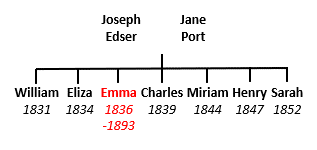 their parents Joseph and Jane at nearby Spurwell Farm, Hoe. Emma’s brother Charles, although only 12, was already working as an agricultural labourer like their father. Emma’s widowed grandmother, 78-year-old Sarah Port, was also there, noted as a ‘pauper’ 4.
their parents Joseph and Jane at nearby Spurwell Farm, Hoe. Emma’s brother Charles, although only 12, was already working as an agricultural labourer like their father. Emma’s widowed grandmother, 78-year-old Sarah Port, was also there, noted as a ‘pauper’ 4.
On 9th June 1855, Emma married local labourer Henry Hersey in St James’ Church 5. They lived close by in Sutton (-by-Shere) where their first child William was born in February 1857, followed by Lucy two years later and Amy in 1863 6, 7, 8, 9. A third daughter, named Emma after her mother, followed in May 1866, but 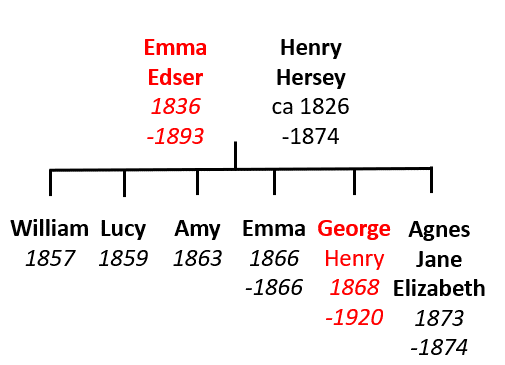 only lived for six days because of ‘debility from birth’ 10. The family were given assistance by the Guildford Union to cover the cost of the baby’s coffin and funeral expenses 11.
only lived for six days because of ‘debility from birth’ 10. The family were given assistance by the Guildford Union to cover the cost of the baby’s coffin and funeral expenses 11.
Henry and Emma’s second son, George, was born on 16th November 1868, with his baptism held privately just six days later 12, 13. The baptism may have been held early because of fears for his health following his sister Emma’s premature death two years earlier, but there proved to be no problems with George.
Henry and Emma continued to live in Sutton, occasionally receiving small amounts of help from the Guildford Union for family illness 14, 15. Their last child, Agnes Jane Elizabeth lived for just seven months, passing away in May 1874 from ‘convulsions from teething’, a cause of death, now known to be incorrect, that was sometimes given at that time 16. More bad news followed when Emma’s husband Henry died just eight days later from pleurisy and pneumonia, aged 48 17.
“A Homeless Family” – Workhouse for Emma and George
Widow Emma now had two young children to care for, 5-year-old George and Amy, 10. She would probably have relied upon her 17-year-old son William’s meagre income as an agricultural labourer and on poor relief to stay out of the workhouse. Her other daughter Lucy was 15 and would most likely have already moved away.
Life was clearly difficult for Emma and would become even tougher. In Autumn 1879, Emma, William and George lost their home and were charged with vagrancy when caught sleeping rough in a farm shed in Shere and on the common 18. Amy, now about 16, was no longer with her mother.
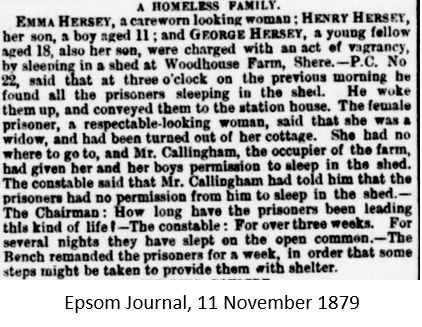 At Guildford’s County Bench, Emma, described by the report as ‘a respectable-looking woman’, said that she was a widow and had been turned out of her cottage. Emma said that the farm’s owner had given them permission to sleep in the shed, but the policeman who had discovered them there said that this was not the case. The Bench decided that Emma and her sons should remain in custody until it could be decided how they could be provided with shelter.
At Guildford’s County Bench, Emma, described by the report as ‘a respectable-looking woman’, said that she was a widow and had been turned out of her cottage. Emma said that the farm’s owner had given them permission to sleep in the shed, but the policeman who had discovered them there said that this was not the case. The Bench decided that Emma and her sons should remain in custody until it could be decided how they could be provided with shelter.
It is likely that this is when Emma and George went into the Guildford Union Workhouse, with the 1881 Census listing Emma, 44, and 12-year-old son George, a scholar, as inmates 19. Emma was recorded as a widowed domestic servant, but the Census said, in the blunt language of the time, that she was a ‘lunatic’. Why Emma’s condition was noted like this has remained unclear, and may have been an enumerator error. No record has been found to show her being admitted to the nearby Brookwood Asylum nor has any other reference to her mental health been traced.
Emma’s other children were all in employment in 1881. William, 24, was at Suttonplace farm, Shere working as an agricultural labourer 20. Single mother Lucy, 23, was in Walthamstow, Essex, employed as an ironer at ‘The Branch of the Poplar Home for Reclaimed Women’ with her 10-month-old daughter. Amy, 17, was a kitchen maid in Paddington, London 21, 22.
Emma returns to the Shere area
There are no records to show when Emma and son George left the Workhouse, but it may well have been soon after George’s 13th birthday in November 1881 when he would have been eligible for employment.
Several years later when George enlisted in the Army in June 1888, his mother was living at Tan Yard House, Gomshall 23. On the 1891 Census she was a housekeeper, boarding in the house of widowed bricklayer Albert Sherlock and his five children at Peaslake, just south of Shere 24. No reference was made to her mental health on this Census, which also did not make clear whether she was working for the Sherlock family or just lodging there.
Not long after, Emma found herself in the Workhouse once more, probably in the Infirmary, suffering from ‘ovarian dropsy’ (ovarian cysts) 25. In October 1893, at the request of the Guildford Union, Emma was admitted to the Royal Surrey County Hospital in Guildford for an operation to remove her ovaries. Four weeks later, she died there on 26th November aged 57 from peritonitis and exhaustion 26. Her funeral was held at Shere’s St James’ Church 27.
George’s later life – Army, prison and domestic intrigue
George was an engine driver when, aged 18 years six months, he enlisted in Guildford for the Queen’s Royal West Surrey Regiment on 12th June 1888. He called himself George Henry, having adopted his late father’s name, and was described as 5 feet 5 inches (1.65m) tall, weighing 115 pounds (52.2kg) with a fair complexion, grey eyes and brown hair. He had signed on for seven years, with five more years in the Army Reserve after that. Serving with the 2nd Battalion, he spent three years at home, before his Battalion was sent to India in January 1891.
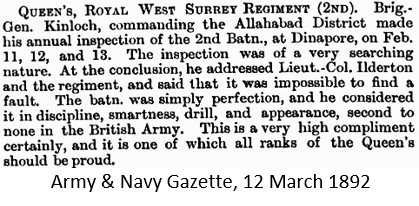 George was clearly with a well-drilled Battalion, as a three-day military inspection in Dinapore (now Dunapur), India by a visiting brigadier in February 1892 found them to be ‘simply perfection’ 28.
George was clearly with a well-drilled Battalion, as a three-day military inspection in Dinapore (now Dunapur), India by a visiting brigadier in February 1892 found them to be ‘simply perfection’ 28.
The Battalion arrived back in England in February 1894 and were soon in the Surrey area where George met Beatrice Ellen Wye from Westcott, Dorking 29. George, 25, was moved to the Army Reserve on 15th June 1895 by which time 19-year-old Beatrice Ellen was pregnant, leading to their marriage at Epsom’s Christ Church on 18th July 1895 30. George gave his new civilian occupation as ‘Attendant at Asylum’.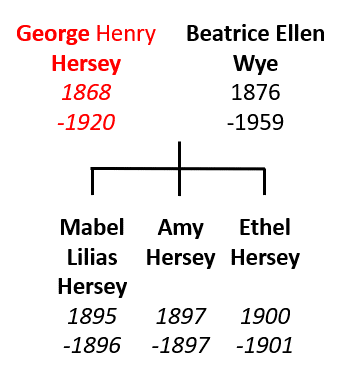
The couple lived in Kingston Lane, Epsom with daughter Mabel Lilias born soon after, although she died in March 1896 of ‘convulsions’ aged 4 months 31. George was now working as a farm labourer.
Their second daughter, Amy, born in June 1897, only survived for 2 months, passing away from ‘gastro-enteritis’ 32.
Despite these personal tragedies, George soon had something else to face as he was recalled to Army active service soon after the 2nd Boer War broke out in South Africa on 11th October 1899. However, George seemed to have been unwilling to rejoin as he deserted on 17th October before being arrested and placed ‘in confinement awaiting trial’. This was held in Guildford on 8th November 1899 with George sentenced to eight weeks in gaol for ‘absenting himself without leave’ 23. Following his imprisonment, he returned to his Battalion and in mid-February 1900 departed for South Africa, spending over a year engaged in the Boer War.
George returns from South Africa and gets a nasty shock
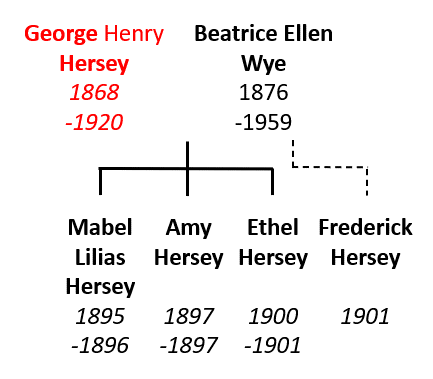 George’s term of service meant that he came home before the Boer war had ended, leaving the Army in June 1901. He was reunited with his wife Beatrice Ellen, now living in Croydon, and met for the first time his 7-month-old daughter Ethel born the previous November 33.
George’s term of service meant that he came home before the Boer war had ended, leaving the Army in June 1901. He was reunited with his wife Beatrice Ellen, now living in Croydon, and met for the first time his 7-month-old daughter Ethel born the previous November 33.
However, there was a shock for George – Beatrice Ellen was pregnant again and he was most certainly not the father.
George and Beatrice’s third daughter Ethel died in September aged just 10 months from ’convulsions due to teething’, meaning none of their three children reached their first birthday 34.
Two months later, in November 1901 Beatrice Ellen gave birth to Frederick, registering her husband George, still a farm labourer, as the father 35.
A relationship with Alice Searle
George had almost certainly left Beatrice Ellen some time earlier, as on Christmas Eve 1901, he was admitted to the Chertsey Union Workhouse in Ottershaw from Windlesham, with laundress Alice Searle and her children Charles (8) and Albert (7) 36.
This was not Alice and her family’s first time as Chertsey Workhouse inmates as they had been there at the time of the March 1901 Census, having been brought in by the police for an unspecified reason 37, 38.
George’s new partner Alice had married labourer Albert Searle in Bagshot in 1887, where the family were living at the time of their youngest child Albert’s baptism in December 1894. This is the last record traced for her husband 39-43.
When Alice gave birth to Harriet Rosa Searle in December 1898, the baptism at Bagshot’s St. Anne’s Church noted Alice to be a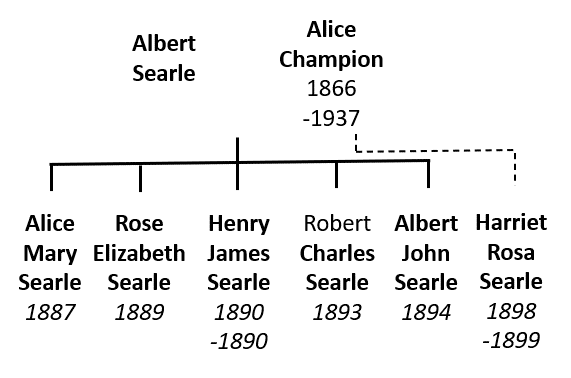 ‘married woman living apart from husband’ 44, 45. There is no record to show who the baby’s father was as George at this time was married to Beatrice Ellen and probably living in Epsom, and Albert Searle was not named as the father on the birth certificate.
‘married woman living apart from husband’ 44, 45. There is no record to show who the baby’s father was as George at this time was married to Beatrice Ellen and probably living in Epsom, and Albert Searle was not named as the father on the birth certificate.
Harriet Rosa’s baptism had clearly been arranged at short notice, as the baby died the following day from ‘hereditary syphilis’ 46.
No details are known of how or when George Hersey and Alice Searle met, but they, and Alice’s two children (Robert) Charles and Albert, remained in the Chertsey Workhouse until March 1902 when they left ‘at their own request’ 47.
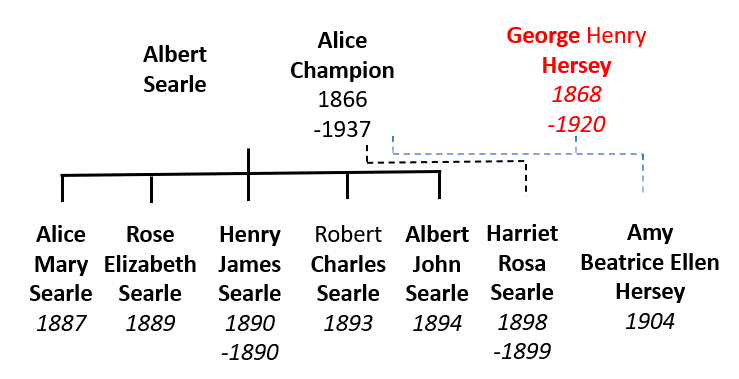 George and Alice were clearly in a relationship as in January 1904, ‘cowman’ George became a father again when Alice gave birth to Amy Beatrice Ellen Hersey in Knaphill, Woking 48. Whatever the terms were that George and his wife Beatrice Ellen had parted on, it seems somewhat strange that he used her names for his and Alice’s daughter.
George and Alice were clearly in a relationship as in January 1904, ‘cowman’ George became a father again when Alice gave birth to Amy Beatrice Ellen Hersey in Knaphill, Woking 48. Whatever the terms were that George and his wife Beatrice Ellen had parted on, it seems somewhat strange that he used her names for his and Alice’s daughter.
Life was clearly extremely difficult for the family as four months later, Alice’s 11-year-old son Charles was admitted to the Chertsey Union Workhouse 49. He was there until December 1904 when he was moved to a Dr Barnardo’s Home in Stepney, east London 50, 51. The following August, Charles agreed to be emigrated to Canada under the Home Children Scheme 52. He settled in Canada, remaining there for the rest of his life 53.
Few records have been traced for the family over the next few years, although they were inmates of the Guildford Union Workhouse in March 1907 when George and Alice’s daughter Amy was baptised at Guildford’s Christ Church 54.
George and Alice settle in Guildford
By 1911, the family was living in Burpham, Guildford, all using George’s surname, Hersey 55. The Census entries that year were written by the head of the house, so George wrote that he was a 43-year-old farm labourer and had been married for 17 years to Alice, and that they had 2 children ‘born alive to present marriage’. Those children were 7-year-old Amy, and Albert, 17. There is no trace of a marriage between George and Alice, and George had married Beatrice Ellen about 17 years ago, but what was written implies that Albert was George’s son, despite Albert’s birth and baptism records saying otherwise. More likely, it was just their way of making the family unit appear legitimate – there was certainly no mention on the Census of the unfortunate short life of Alice’s daughter Harriet Rosa 12 years earlier.
On 3rd April 1911, the day following the Census, Albert, like George had done back in 1888, signed up for the Queen’s Royal West Surrey Regiment, under his birth name Albert Searle 56. Albert’s 1st Battalion was one of the first to arrive in France in August 1914 just a few days after the start of the First World War 57, 58. At the Battle of Ypres two months later, the Regiment suffered heavy losses with Albert taken prisoner 59. He remained under capture for more than four years until the end of the War in November 1918 at the north German prisoner-of-war camp in Gustrow, Mecklenburg 60, 61.
George and Alice, now living at 29 Stoughton Road, Guildford, welcomed Albert back in January 1919 62. Six months later, the family had a wedding to enjoy when Albert, now working as a boilerman, married Cissie Emmie Joy at Guildford’s St Nicolas Church 63. Albert named his father as Albert Searle, seemingly ending the possibility of his father being George.
George’s time with Albert and Cissie was all too brief, as George was admitted to Guildford’s County Hospital suffering from a kidney infection, passing away there on 23rd January 1920, aged 51 64.
Alice Searle Hersey
George’s ‘widow’ Alice remained in Stoughton Road and at the time of the 1921 Census had five relatives with her. 17-year-old Amy, her daughter with George, was a bottle washer at the nearby Friary Brewery 65. Alice’s eldest daughter from her first marriage, Alice Ellis, her husband and their three young children, were also there 66.
Amy married in February the following year, and the Ellis family had moved to Burpham, so Alice would probably have been alone now at her home 67, 68. She remained in Stoughton Road until she was admitted to the Guildford Infirmary in Warren Road, part of the original Guildford Union Workhouse, where she died from cancer on 6th December 1937, aged 71 69.
Postscript – George’s wife Beatrice Ellen
George’s wife Beatrice Ellen, whose out of wedlock child Frederick Hersey saw her husband leave home, remained for a time in Croydon, where ‘Frederick George’ was baptised in June 1904 70. He was noted as a ‘nurse child’, meaning he was not being cared for by Beatrice Ellen, although she and George were named on the baptism record as the parents. Frederick was adopted by a married couple from Croydon 71.
Beatrice Ellen lived in Epsom with ‘husband’ John William Pearce, although no record has been traced of a marriage. They had seven children between 1906 and 1922, with the last one named Frederick George, the same as her child sent for adoption 72, 73. She passed away in 1959 74.
January 2021, updated October 2025
We’d love to hear from you if you are a relative of this family.
Please contact us by email: spikelives@charlotteville.co.uk
Sources and References
Original Guildford Union Minute Books, Chertsey Union Minute Books and Admission & Discharge Registers, Surrey parish records and newspapers are all available at the Surrey History Centre, Woking. Ancestry.co.uk and British Newspaper Archive/FindMyPast.co.uk were used for digitised records online. A complete list of sources and references may be found here: Emma and George Hersey References
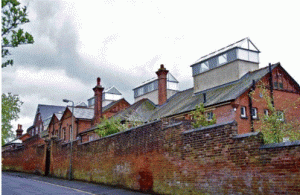 Spike Lives is a Heritage project that chronicles the lives of inmates, staff and the Board of Guardians of the Guildford Union Workhouse at the time of the 1881 Census. The Spike Heritage Museum in Guildford offers guided tours which present a unique opportunity to discover what life was like in the Casual/Vagrant ward of a Workhouse. More information can be found here
Spike Lives is a Heritage project that chronicles the lives of inmates, staff and the Board of Guardians of the Guildford Union Workhouse at the time of the 1881 Census. The Spike Heritage Museum in Guildford offers guided tours which present a unique opportunity to discover what life was like in the Casual/Vagrant ward of a Workhouse. More information can be found here
